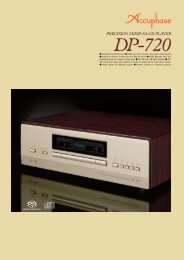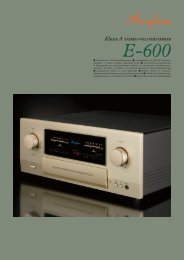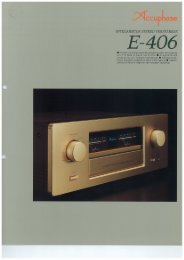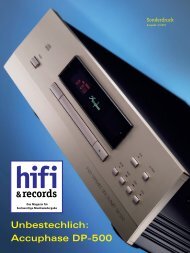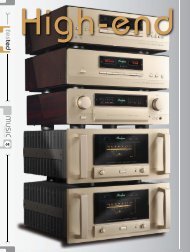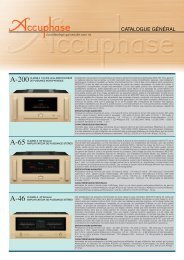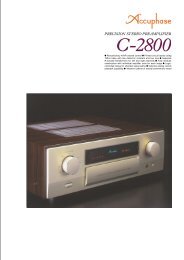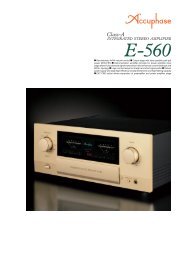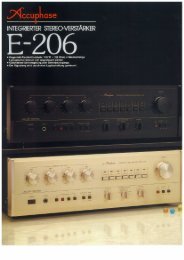m Revolutionary AAVA volume control m Fully modular ... - Accuphase
m Revolutionary AAVA volume control m Fully modular ... - Accuphase
m Revolutionary AAVA volume control m Fully modular ... - Accuphase
You also want an ePaper? Increase the reach of your titles
YUMPU automatically turns print PDFs into web optimized ePapers that Google loves.
The C-2810 inherits the superb design technology<br />
of the C-2800 but takes another signifi cant step forward.<br />
The new model employs only top-quality parts<br />
selected after extended listening tests and features<br />
a further improved <strong>AAVA</strong> (<strong>Accuphase</strong> Analog Varigain<br />
Amplifi er) <strong>volume</strong> <strong>control</strong>. How a preamplifi er<br />
handles listening level adjustment has a decisive<br />
infl uence on its performance and sound. <strong>AAVA</strong> is<br />
an innovative concept that differs radically from<br />
conventional variable-resistor type <strong>volume</strong> <strong>control</strong>s.<br />
In <strong>AAVA</strong>, amplifi cation and <strong>volume</strong> <strong>control</strong> are fully<br />
unifi ed, eliminating all mechanical contact points.<br />
Pure analog processing ensures optimum performance<br />
and superb sound. Another benefi t of <strong>AAVA</strong><br />
is that its performance and sound quality will remain<br />
undiminished for many years to come.<br />
The power supply section of the C-2810 employs<br />
two separate R-toroidal transformers, one for each<br />
channel. Filtering capacitors and all other parts of the<br />
power supply are also duplicated for left and right.<br />
What’s more, all unit amplifi ers such as for input<br />
buffer, <strong>AAVA</strong>, and balanced output are also entirely<br />
separate for the two channels, arranged on a highquality<br />
motherboard. This fully monaural construction<br />
prevents unwanted crosstalk and interaction both on<br />
the electrical and the physical plane. The result is<br />
utterly stable playback sound of impeccable quality.<br />
Logic relay <strong>control</strong> is used for source switching to<br />
implement the shortest possible signal paths. Each<br />
input position allows individual phase selection. The<br />
printed circuit boards are an important element of a<br />
preamplifi er both regarding electrical performance as<br />
well as sound quality. In the C-2810, these are made<br />
from a Tefl on material with low dielectric constant<br />
and minimum loss. Every aspect of this top-notch<br />
analog preamplifi er has been honed for optimum<br />
sonic performance. The overall result is a fl agship<br />
product that represents the best that <strong>Accuphase</strong><br />
has to offer.<br />
INPUT<br />
BUFFER<br />
BUFFER<br />
Input music signal<br />
V- I Converter<br />
Meet the new fl agship model – Preamplifi er with further improved<br />
revolutionary <strong>AAVA</strong> <strong>volume</strong> <strong>control</strong>. Complete dual<br />
mono construction with two R-toroidal power transformers.<br />
Modular amplifi ers using printed circuit boards made from Teflon.<br />
Independent phase selection for each input position. Phono<br />
Equalizer Unit allowing high-quality playback of analog records.<br />
n Logic-<strong>control</strong>led relays assure<br />
high sound quality and<br />
long-term reliability<br />
The strategically placed relays<br />
of the C-2810 prevent any signal<br />
degradation that could occur if<br />
the signal has to travel a long way<br />
for input and output connection<br />
Balanced inputs and outputs Unbalanced inputs and outputs<br />
and function switching. Optimum signal fl ow is maintained at all times.<br />
n Ideal power supply uses “R-toroidal transformers” in fully<br />
monaural confi guration<br />
Each transformer is housed in a dual-wall enclosure with a glass fi ber<br />
core and strong resin coating. In addition, epoxy fi ller with superior<br />
vibration-damping and insulation characteristics is used, resulting in<br />
highly effective triple insulation.<br />
n Printed circuit boards in signal transmission circuitry made<br />
from Tefl on (glass fl uorocarbon resin substrate) with low<br />
dielectric constant and low loss<br />
* Tefl on is a registered trademark of DuPont USA.<br />
n Selectable preamp gain<br />
The overall gain of the preamplifi er can be set to 12 dB, 18 dB, or<br />
24 dB. (Standard position is 18 dB.)<br />
n EXT PRE function allows use of external preamplifi er<br />
n Independent phase selection for each input position<br />
The selected phase setting is memorized for each input position<br />
separately. The on/off status of a LED indicator shows the respective<br />
setting.<br />
n Versatile input and output connectors (inputs shown as<br />
character display)<br />
n Dedicated headphone amplifi er optimized for sound quality<br />
n Versatile features:<br />
m Provisions for recording/playback/copying with two recorders<br />
m Loudness compensator augments bass and treble at low listening<br />
<strong>volume</strong><br />
m Attenuator<br />
m Subsonic fi lter removes ultra low frequency noise<br />
n Massive cabinet made of persimmons wood<br />
CPU<br />
Volume<br />
Balance<br />
Attenuator<br />
I-V Converter<br />
GAIN<br />
VOLUME<br />
5<br />
4 6<br />
3 7<br />
2 8<br />
1 9<br />
MIN MAX<br />
OUTPUT<br />
Response in dB<br />
R-toroidal transformer<br />
Gain selector<br />
EXT PRE function and phase selector button,<br />
with LED indicators<br />
18<br />
16<br />
14<br />
12<br />
LOUDNESS COMPENSATOR: ON<br />
10<br />
COMP.2<br />
8<br />
6<br />
COMP.1<br />
4<br />
COMP.2<br />
2<br />
0<br />
COMP.1<br />
-2<br />
-4<br />
-6<br />
10 100 1k 10k 100k<br />
Frequency in Hz<br />
Loudness compensator characteristics<br />
<strong>AAVA</strong> (<strong>Accuphase</strong> Analog Vari-gain Amplifi er) <strong>volume</strong> <strong>control</strong><br />
Conversion into current with 16<br />
weighting stages (1/2–1/2 16 )<br />
16 current switches (65,536<br />
possible combinations)<br />
CPU detects position of <strong>volume</strong> knob<br />
and operates current on/off switches<br />
according to knob position<br />
Operation principle of <strong>AAVA</strong> in<br />
C-2810<br />
Current<br />
values are<br />
added<br />
Reconversion<br />
of current into<br />
voltage<br />
Volume knob is turned and<br />
position is detected<br />
<strong>AAVA</strong> is a radically different <strong>volume</strong> <strong>control</strong> principle that<br />
does not use variable resistors and provides top-notch<br />
performance and sound quality. Because the music<br />
signal does not pass through variable resistors, it is not<br />
affected by changes in impedance. This means that high<br />
signal-to-noise ratio and low distortion of the signal are<br />
maintained at any <strong>volume</strong> <strong>control</strong> setting.<br />
n <strong>AAVA</strong> resolution<br />
<strong>AAVA</strong> adjusts the listening <strong>volume</strong> by means of 16 weighted V-I<br />
converter amplifi ers which are <strong>control</strong>led by current switches.<br />
The number of possible <strong>volume</strong> steps set by the combination of<br />
these converter amplifi ers is 2 to the power of 16 = 65,536.<br />
n <strong>AAVA</strong> ensures high S/N ratio and uniform frequency<br />
response<br />
With conventional <strong>volume</strong> <strong>control</strong>s, the impedance increases<br />
signifi cantly at settings that correspond to normal listening levels,<br />
thereby leading to increased noise. With <strong>AAVA</strong>, there is no<br />
change in impedance and consequently no deterioration of S/N<br />
ratio. Frequency response also remains totally uniform. Changing<br />
the <strong>volume</strong> with <strong>AAVA</strong> does not mean introducing noise or<br />
detracting from the high performance of the amplifi er.<br />
n No more left/right tracking differences or crosstalk<br />
Because <strong>AAVA</strong> is an electronic circuit employing fixed-value<br />
resistors, there is virtually no left/right tracking error also<br />
at low <strong>volume</strong> levels. Since channels can be kept separate,<br />
crosstalk also does not present a problem.



